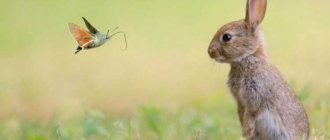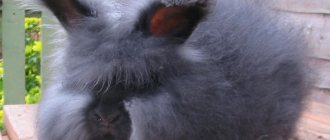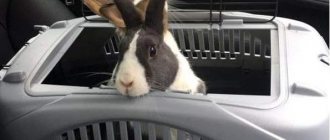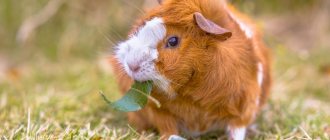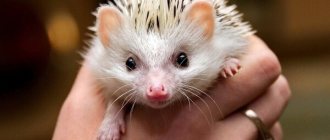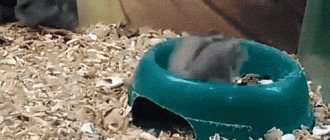As a responsible pet owner, one of the main aspects of caring for your pet is eating a healthy and balanced diet. This diet is usually as close as possible to what the animal would be fed in the wild. If you are a gerbil owner, feeding them a balanced and nutritious diet is important to keeping your gerbils healthy and happy. Therefore, it is very important to understand their nutritional needs. Here's everything you need to know about feeding gerbils.
Who is a gerbil
Gerbils are a subfamily of rodents. Outwardly they resemble a rat (but cuter). The hind legs are elongated, which allows gerbils to stand on their hind legs and jump well (large individuals can jump 3.5 m).
They lived quietly in the desert areas of Africa and Asia, until people noticed that animals are easy to keep, unpretentious in care and treat people well. The first exhibition of already domesticated gerbils took place in the 60s of the twentieth century.
Then people decided that the sandy color, suitable for camouflage in the desert, was not good enough for a pet. And they developed a huge variety of shades (we will return to the list of breeds later).
Training and games
Gerbils are very playful rodents.
Gerbils are very curious animals. It’s worth building communication with a new pet and training it on this feature.
Before you begin to master joint games with the animal, you should accustom it to your hands. To do this, offer the rodent various treats. Sooner or later he will come closer and stop being afraid. Do not make sudden movements - this may frighten the animal.
Gerbils enjoy playing with humans. They love to run along hands, climb into sleeves and make their way through a kind of tunnel. With frequent communication, mice get used to the owner and independently climb onto his shoulder, from where they enjoy watching everything that happens. During the games, you can periodically feed your friend.
Do not frighten or scold the mammal under any circumstances; in response to this, it may bite or stop approaching the person.
Behavior at home
Most species of gerbils sleep at night and are active during the day. But not all of them, so you can buy an animal that will not give you rest at night. Check with the seller what time of day rodents sleep.
It’s not for nothing that we mentioned activity - gerbils do not sit still. They are always in motion: you are unlikely to be able to hold them in your arms and stroke them for more than a few seconds (unless, of course, you force your pet, but this cannot be done).
Owning a gerbil is worth it for those who agree to watch the rodent more, rather than “squeeze” it.
However, gerbils have a very friendly nature. They get used to the owner and his voice. They can be litter trained and played with.
The animal treats people well.
We train to the toilet in several stages (select only one individual and train it immediately).
- When the gerbil has gone the wrong way, we take the balls of excrement and put them in the tray. We look at the reaction: if the toilet still does not attract rodents, move on to the next step.
- We keep an eye on the rodents, and as soon as we see that the pet has sat down to “go big,” we carefully pick it up and carry it to the tray. This requires patience and it won’t take you to get the hang of it right away, but it works. And it’s easier to care for the animals later - the time spent is worth it.
- If you manage to train one pet to use the toilet, the rest usually begin to repeat its actions. But if individual individuals “fundamentally” do not want to live in a “civilized” manner, repeat the steps for them separately.
Another important point: gerbils in nature live in large colony families, so they feel much better in company. The owner cannot replace their relatives, even if they devote a lot of time to caring for the pet and playing.
Keep your gerbils at least two at a time. If you are not going to breed them, get all females.
Animals should be together since childhood. If you later try to add a third animal to an already living couple (in a month, for example), they will not accept it.
A little about the relationship between gerbils. Sometimes they may struggle a little, but that's okay. But if the fight leads to blood, then immediately seat your pets. Not for long, for a few hours (you can’t separate for a long time, so as not to forget each other’s smell).
Now a little about the negative aspects of keeping gerbils.
They chew all the time. They chew everything they come across, so make sure that it is not your furniture (more on that below). When gerbils are not gnawing, they are digging; therefore, dirt is guaranteed (but this is not a problem if you choose the right house: we will tell you how to make cleaning easier).
Males also mark territory. Of course, the “amber” is not like the March cat, but keep this in mind. Females can too, but this is less common. There is no need to worry about this: gerbils have very little odor (less than, for example, hamsters).
What do gerbils eat in the wild?
Today, more than 100 species of gerbils are known. These animals are rodents and belong to the mouse-like group. They really look like mice, but are much smaller in size. The animals' slightly elongated hind limbs, as well as the charming tassel on their fluffy tail, give them a resemblance to jerboas. But they do not move in leaps, but in the usual way, like all their close “relatives” - rats, mice and hamsters.
The gerbil has a pointed muzzle, the eyes are large and slightly protruding, and the ears are always in an erect position. The animal is accustomed to warily listening to the world around it.
Over the years of evolution, the fur of rodents has acquired a camouflage coloring; its color varies from brown to yellowish shades, becoming lighter towards the belly and limbs. Some species of animals have light spots near the eyes and ears.
Table 1. Gerbil sizes
| Body length(mm) | Tail length(mm) | Weight (g) |
| 50–200 | 55–245 | 15–230 |
Animals use visual, auditory, chemical and tactile perception of the environment. Pheromones are used to exchange information, which help indicate social and reproductive status. Males mark their territory with a characteristic odor - they use the ventral (sebaceous) glands.
Habitat
Gerbils live in India and Africa, China, Mongolia, and central Asia. The animals' favorite habitats are deserts and semi-deserts, savannas, and dry steppes. Some species of these rodents prefer damp forests, mountain valleys, and agricultural lands.
Gerbils are accustomed to living in difficult climatic conditions and have adapted to hot weather. Over the years of evolution, their body has developed a system of protection against dehydration. To reduce fluid loss, as well as reduce the need for water, the gerbils’ body “forgot how” to sweat. This leads to the need to limit the presence of animals in high temperature conditions. Gerbils will survive in the heat of +45°C for no more than 2 hours.
Nutrition
In nature, gerbils feed on the types of plant fiber that are available in the region where they live. Animals use:
- all parts of plants, including tubers;
- seeds;
- fruits of fruit trees that fell to the ground.
In addition to plants, animals catch insects, hunt small reptiles, and do not disdain other rodents. They love to destroy bird nests and eat eggs or chicks. Slugs and snails are a rare delicacy for gerbils that live in dry climates, and almost daily for those living in humid forests.
Gerbils that live in warm or hot climates eat their food as soon as they find it, before larger predators take the food. Animals from cool regions store food supplies inside large pantries, which they build at a depth of more than 1 m.
Sometimes the weight of food stored by one rodent reaches several tens of kilograms.
What to buy for your pet
To comfortably keep a gerbil at home and care for it, you will need:
- house (cage, aquarium, terrarium, dune);
- “ware” for feeding and bathing;
- "sports equipment";
- a few little things necessary for proper care.
Now about everything in detail.
How to choose a house
The gerbil is very different from other domestic rodents, and therefore the requirements for its maintenance are specific. Based on them we will choose a house.
Cell
Pros:
- good ventilation,
- If the grille is removable, the cage is easy to clean.
Minuses:
- debris flying from the "excavations"
- pets get injured on the bars.
The cage is inexpensive, but it is not suitable for gerbils. As we already mentioned, they dig and chew all the time. The litter flies in all directions, and the wooden cage is simply “eaten up.” Even if the rods are steel, the animals then lose hair on their faces. If you still decide to take a cage, take it with a very high plastic tray (10 centimeters), so at least it will be easier to care for. We recommend a tray size for a pair of gerbils of at least 50x70 cm.
As an option - a terrarium cage with a high glass tray. But even this may not save you from garbage.
Aquarium, terrarium
Pros:
- garbage will definitely not fly out from behind such walls,
- You can watch your favorites play.
Minuses:
- not the most convenient option for care,
- obstructed air circulation,
- Gerbils jump high, so the aquarium needs to be covered.
More minuses than pluses. Changing the bedding is inconvenient; closing the lid reduces the air flow. But if you organize ventilation, then why not: it certainly won’t harm the gerbils. The only thing is that an aquarium of the required size will be expensive, and their shape is most often very elongated, designed for viewing fish “like on TV.”
Not a bad budget option.
Box for rodents (dune)
Pros:
- the filler does not spill out,
- Maintenance is simple – just open the lid,
- everything looks good
- easy to carry from place to place.
Minuses:
- not detected.
The best option, in our opinion. A potential problem arises if placed in direct sunlight (depending on the quality of the plastic, it may melt or release harmful substances), but this is not recommended in principle. In any case, choose decent companies in decent stores.
This is such a simple design. All that remains is to add accessories.
What to place in the house
- Toilet tray.
- Feed container. Place it higher, on a stand, otherwise you won’t be able to dig it out later. But there are breeders who sprinkle food on the bedding: it is believed that this method of obtaining food is more natural for gerbils. We won’t give preference to one option - try both, you’ll like one better.
- Drinking bowl of any design. Preferably with a metal spout (they chew!). The water needs to be changed every day to prevent the growth of bacteria. Gerbils hardly drink, but they need a supply of water just in case.
- Mineral and salt stones to replenish mineral deficiencies.
- Twigs for grinding teeth, otherwise the gerbils will find something to chew on. Choose wood from fruit trees (such as cherry, apple), as well as maple, acacia and willow.
- Running wheel. “Deaf”, not “ladder”. The hind legs and tail can get stuck in the gaps.
- House for sleeping. The gerbil needs a place where it can hide from prying eyes or just in the shade from the light. Perhaps your pets will not use it - sometimes they sleep in holes dug by themselves.
- Labyrinths, bridges and other similar “entertainment”. How much will fit, the more the better.
Filler
Sawdust will do. Just not the ones that look like dust, but small shavings. Do not use pine sawdust - its secretions sometimes lead to respiratory diseases. Aspen sawdust has proven itself well.
Many people use undyed, unscented paper, such as napkins.
If you want to make care easier, buy ready-made litters and bedding for gerbils. There are a huge number of varieties, it’s worth trying several to understand which ones you are more comfortable with and which ones your pets like.
One of the most important points for filler is the thickness of its layer. Gerbils love to dig and are constantly building new holes. We recommend pouring at least 10 cm, and preferably 15.
Home care
Gerbils have almost no smell, so the bedding can be changed once a week (of course, this depends on how many pets you have, so you will have to find out the exact number experimentally). Daily care is only required to remove leftover perishable food.
Who took the apple? I just hid it yesterday...
Keeping and caring for the Mongolian gerbil
In the photo: Mongolian gerbil
Gerbils can be kept in an aquarium (equipped with a lid and well ventilated) or in a metal cage. These animals are kept in pairs or small families.
The room temperature must be maintained at +20...23 degrees (minimum permissible temperature +15 degrees).
Avoid drafts and direct sunlight.
Gerbils constantly dig, so sprinkle sawdust (not pine!) at the bottom of their “apartment” in a layer of 10 - 15 cm. To build a nest, you will need hay or simple toilet paper. Fabric is a bad choice: the animal can get tangled in the threads.
The drinking bowl is attached outside the cage or inside, but make sure that it does not leak and the sawdust remains dry. If the bedding rots, the gerbils will get sick.
The feeder is suspended above the sawdust level or placed on the second floor of the cage.
Gerbils need to wear down their teeth, so provide them with pieces of wood, twigs, or driftwood. They can be found in nature and disinfected before being given to animals, or purchased at a pet store. If you forget about this, the rodent will begin to grind its teeth on the bars of the cage and may even damage its nose.
These small animals cannot live without sand baths, so place a container of sand in the cage 1-2 times a week. Special sand for rodents is sold at pet stores.
Gerbils need to move a lot, and the cage limits their movement. To prevent kids from suffering, buy a wheel. The plastic “shell” will quickly be destroyed, so it is better to choose a metal wheel equipped with a mesh instead of bars. A wheel with crossbars is dangerous.
Plastic is also not a suitable option for a house: your pets will chew it and get sick. The house must be wooden. The cage is cleaned once every 2 weeks. This includes washing (without using detergents) and changing bedding. With proper gerbil care, there are virtually no unpleasant odors from gerbils.
Choosing a pet
You have bought everything you need for care, allocated a place for your new pet, and now it’s time to move on to the most important thing - choosing the animal itself. First, let's take a look at the breeds. There are already more than 110 species of gerbils; we will focus on the most popular.
Gerbil breeds
Mongolian, aka clawed . The most common inhabitant of houses and apartments. The color of the coat is from coal black to snowy white - the breeders took care of diversity. There are even bluish shades. It grows up to 20 cm in length, weighs about 120 g. There is often a small tassel at the end of the tail.
Color options for the “Mongols” can be seen in the video below. But please ignore the advice that it is better to feed the rodent more often with sweets and tropical fruits.
Fluffy-tailed . This species is captivating with its chic tassel on the tail. In stores you usually only find the sand color. Length 10-13 cm.
Fluffy-tailed. This is a tail you can be proud of!
Short-eared . Red or brownish, white belly. Grows up to 12 cm.
Short-eared, but very cute.
Cheeseman's gerbil grows up to 11 cm, with a long tail. The most interesting feature is the huge (relative to the head) eyes.
You can drown in such eyes... Cheeseman's gerbil.
Persian . Quite a large individual (can grow up to 20 cm and gain weight of 170 g). Has a beautiful tassel at the end of the tail.
Persian beauty.
Let's go buy
Where to buy animals - from breeders or in a store - is everyone’s personal choice. We do not agree with the opinion that stores provide poor care and often sneak in already sick animals. Choose a store that is trusted (fortunately, reviews can be found on the Internet without any problems). In a good store and good care. At the same time, we met with private breeders who kept their pets in terrible conditions and tried to sell old gerbils or the wrong sex. Therefore, it does not matter where to buy, but make preliminary inquiries about the seller.
Below are the main points to pay attention to when purchasing.
- If you are going to take pets of different sexes, it is advisable that they be from different parents (to reduce the risk of genetic diseases).
- It is better to take same-sex dogs from the same litter so that they are already accustomed to each other.
- It's great if you can look at your parents. It will be immediately obvious whether they are active or lethargic, friendly or aggressive. Offspring are likely to inherit character traits.
- The best age to buy is 6-9 weeks. If you have no experience, it is difficult to determine age. Bring experienced gerbil keepers with you if possible. If not, rely on reliable sellers.
- Eyes, ears, nose should be free of discharge and inflammation.
- The coat should be smooth, clean and not matted anywhere (feel free to look under the tail).
- There should be no scratches, wounds or rashes on the skin.
- Listen to your breathing, usually if there is wheezing, you can hear it.
- A healthy gerbil is active and inquisitive, but if the animal is lethargic and does not respond to you, then it may be sick.
We are already waiting for new owners :)
Determining gender
Determining sex at such an early age (6-9 weeks, as we recommend for purchase) is difficult, but there are still signs.
If the age is closer to the upper limit, then in males, when you lightly press on the belly, the testes (testicles) protrude. By the way, this is one of the ways to check age, because... They will not perform for very young boys.
Another way. The distance between the anus and the genitals in females is much smaller, literally millimeters. Males have much more.
Is it worth starting
Whether or not to have a sand squirrel at home is, of course, everyone’s business. But I would highly recommend this mouse as a pet. The gerbil, despite its small size, can become a wonderful friend for you. The animal is magnificent as a pet. The only thing I ask you to pay attention to is one detail.
There is a possibility of buying a mouse from the wild. And this can be disastrous for your family. Because wild sand squirrels carry plague and tularemia.
Having acquired such an animal, do not forget to please your new friend from time to time. Bring him small gifts in the form of small branches or twigs. He will happily chew on them. And the more such souvenirs the animal has, the less likely it is that she will eat something valuable while walking around the apartment.
What to feed
We adhere to the point of view that a pet’s diet should be close to natural. Based on this, we will make recommendations. Under natural conditions, gerbils prefer plants (both roots and above-ground parts), their seeds and, occasionally, small insects.
What can a gerbil do?
Nutrition can be divided into 3 groups:
- hay,
- cereals,
- succulent feed,
- greenery.
It is better to buy store-bought hay, because it is difficult to find clean grass and prepare it correctly. But if you have your own plot and you dry the grass yourself, make sure to keep it away from dampness - do not feed rotted hay.
Cereals are the basis of nutrition. You can make your own mixture of wheat, oats and barley (less wheat, more of the rest). Sometimes corn is added.
Juicy foods are vegetables and fruits. Gerbils happily eat carrots, beets, zucchini, and cucumbers. Fruits include apples and pears. Don't forget about berries: strawberries and raspberries.
For “greens,” add lettuce and celery (yes, it’s technically a vegetable). Another good idea is to add pumpkin seeds.
That's for me?
Give with caution
Some people add a lot of nuts and seeds to their gerbils' food. But this is not entirely good, because... They contain a lot of fat, so feed nuts with caution (as well as sunflower seeds).
The same goes for exotic fruits. For example, rodents love bananas, but they also need to be greatly limited.
There is also a “harmful” vegetable – cabbage. It is not poisonous, but often causes bloating and digestive problems in small animals.
Pets rarely need animal protein, but a couple of times a week you can give egg white (boiled), chicken breast or low-fat cottage cheese. Dried insects from a pet store will do. The only exception is pregnant females, they need protein daily.
What not to feed
In this list we boldly include everything that you eat yourself. Add sweets, baked goods, citrus fruits and very sweet fruits/berries (for example, grapes) to the list.
This is not for you, my friend, otherwise you will have health problems.
Ready-made feed
If possible, purchase ready-made food. They already take into account all wishes, plus manufacturers often add vitamin and mineral complexes to the composition.
Unfortunately, special food for gerbils is not available everywhere. You can take food for other rodents (for example, hamsters), just remove the nuts and sunflower seeds from there.
Features of care - recommendations
- If the weather is very hot, then you can moisten the soil 2 - 3 times a week. Spraying - in drought and heat. Do not allow the root system to dry out.
- When the mountain gerbil is grown in a flowerpot, the amount of watering must be reduced in winter.
- After the flowering period, cut off all faded flowers and dried leaves. Sanitary pruning will keep the bushes in well-groomed condition. And the nutrients will go towards the development and growth of the bush.
- Apply fertilizers only once per season. Complex mineral supplements will be sufficient.
How to bathe a gerbil
The animal takes care of its hygiene on its own; it does not need help in caring for it. As a desert dweller, he hates water, so you should bathe him in water only if your pet is very dirty and cannot wash himself off.
And gerbils swim in the sand. To do this, you need to install a separate “bath” with fine sand in the house (the container must be larger than the animal so that it fits there entirely). This kind of sand is sold, for example, for chinchillas.
It is better to install a “closed” bathtub, otherwise there will be sand everywhere. For example, you can put an empty jar on its side or buy a special one.
Chic but impractical bathtub.
Substrate
A fairly thick layer of bedding (two to three inches) in the cage provides a good foundation and allows gerbils to dig. Avoid cedar or pine shavings. Aspen shavings can be used, but most owners prefer one of the many types of paper bedding.
Nesting material that gerbils can shred and use to line their nests is also a good idea. Nesting material sold in pet stores is not suitable for this, as small legs can get tangled in the strands.
It's best to use a plain white face cloth that is unscented and chemical-free and can be cut into strips for your gerbils. You can also use paper towels and/or grass hay for this purpose.
Pet diseases
Gerbils tend to be in good health compared to other rodents, but it doesn't hurt to be aware of common diseases and their symptoms. Do not self-medicate - immediately contact a veterinarian (a rodent specialist is called a ratologist).
- If the eyes are watery and purulent, then it is most likely conjunctivitis. Protect the animal from dust, hide it in a house out of direct rays of light, and as soon as possible, take it to the clinic.
- Nasal discharge may indicate an allergy. Just in case, immediately change the type of bedding, think about what in the diet could give such an effect. If there is no change in a couple of days, call your veterinarian.
- If the belly suddenly begins to increase in size and does not go away, all this is accompanied by diarrhea (i.e. it is not bloating), then this may be Tyzzer's disease (fluid accumulates in the abdominal cavity). The reason is missing food. Most often, there is nothing you can do to help here, so make sure the food is fresh and the house is clean.
Gerbils also suffer from epilepsy and cancer, but in these cases little depends on us.
Regarding vaccination. There are no special medications for gerbils. But if your pet does not come into contact with other people’s rodents, then there is nothing to be afraid of.
Food options
Seed collections in the form of loose mixtures of seeds with the addition of granules and/or pieces of dried vegetables and fruits.
Most formulas are nutritionally balanced as long as your gerbil eats the entire contents. However, they like to choose their favorite foods and ignore the rest. If certain components are persistently avoided, this leads to dietary imbalance.
The answer is at the end of the article
